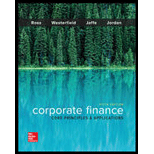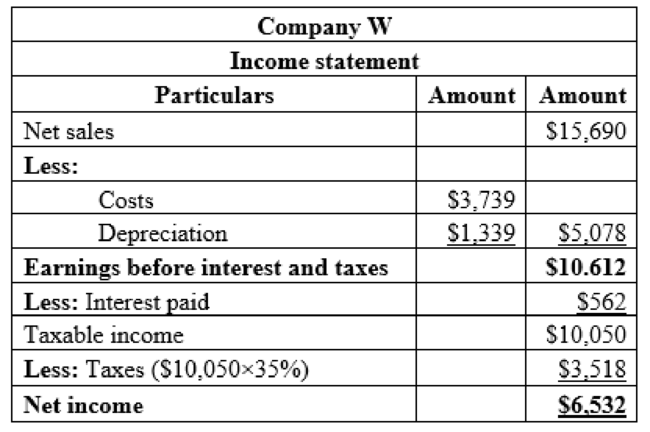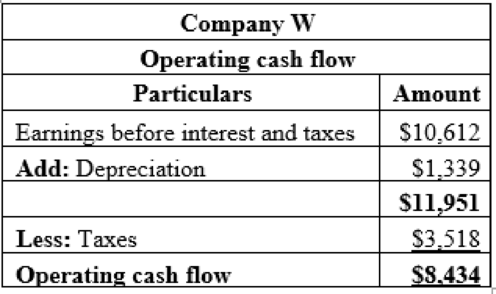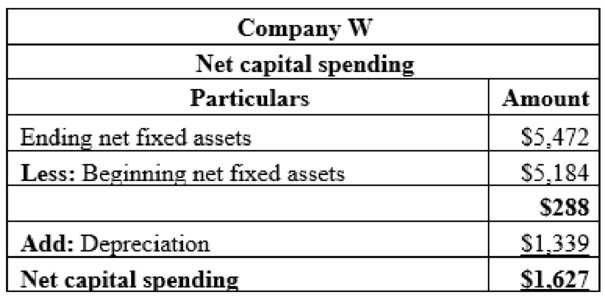
a)
To calculate: The shareholders’ equity for 2017 and 2016.
a)
Explanation of Solution
Compute the total assets for 2016:
Hence, the total assets for 2016 is $6,250.
Compute the total liabilities for 2016:
Hence, the total liabilities for 2016 is $3,355.
Compute the
Hence, the stockholders’ equity for 2016 is $2,895.
Compute the total assets for 2017:
Hence, the total assets for 2015 is $6,617.
Compute the total liabilities for 2017:
Hence, the total liabilities for 2017 is $3,608.
Compute the stockholders’ equity for 2017:
Hence, the stockholders’ equity for 2017 is $3,009.
b)
To calculate: The change in net working capital for 2017.
b)
Explanation of Solution
Compute the ending net working capital:
Hence, the ending net working capital is $627.
Compute the beginning net working capital:
Hence, the beginning net working capital is $591.
Compute the change in net working capital:
Hence, the change in net working capital is $36.
c)
To calculate: The cash flow from assets for 2017, and the fixed assets sold in 2017.
c)
Explanation of Solution
Compute the net income:

Hence, the net income is $6,532.
Compute the operating cash flow:

Hence, the operating cash flow is $8,434.
Compute the net capital spending:

Hence, the net capital spending is $1,627.
Compute the cash flow from assets:
Hence, the cash flow from assets is $6,771.
Compute the fixed assets sold:
Hence, the value of fixed assets sold is $1,113.
d)
To calculate: The cash flow to creditors and the amount of long-term debt paid off.
d)
Explanation of Solution
Compute the net new borrowing:
Hence, the net new borrowing is $210.
Compute the cash flow to creditors:
Hence, the cash flow to creditors is $352.
Compute the debt paid off:
Hence, the value of debt paid off is $424.
Want to see more full solutions like this?
Chapter 2 Solutions
Corporate Finance: Core Principles and Applications (Mcgraw-hill Education Series in Finance, Insurance, and Real Estate)
 Essentials Of InvestmentsFinanceISBN:9781260013924Author:Bodie, Zvi, Kane, Alex, MARCUS, Alan J.Publisher:Mcgraw-hill Education,
Essentials Of InvestmentsFinanceISBN:9781260013924Author:Bodie, Zvi, Kane, Alex, MARCUS, Alan J.Publisher:Mcgraw-hill Education,

 Foundations Of FinanceFinanceISBN:9780134897264Author:KEOWN, Arthur J., Martin, John D., PETTY, J. WilliamPublisher:Pearson,
Foundations Of FinanceFinanceISBN:9780134897264Author:KEOWN, Arthur J., Martin, John D., PETTY, J. WilliamPublisher:Pearson, Fundamentals of Financial Management (MindTap Cou...FinanceISBN:9781337395250Author:Eugene F. Brigham, Joel F. HoustonPublisher:Cengage Learning
Fundamentals of Financial Management (MindTap Cou...FinanceISBN:9781337395250Author:Eugene F. Brigham, Joel F. HoustonPublisher:Cengage Learning Corporate Finance (The Mcgraw-hill/Irwin Series i...FinanceISBN:9780077861759Author:Stephen A. Ross Franco Modigliani Professor of Financial Economics Professor, Randolph W Westerfield Robert R. Dockson Deans Chair in Bus. Admin., Jeffrey Jaffe, Bradford D Jordan ProfessorPublisher:McGraw-Hill Education
Corporate Finance (The Mcgraw-hill/Irwin Series i...FinanceISBN:9780077861759Author:Stephen A. Ross Franco Modigliani Professor of Financial Economics Professor, Randolph W Westerfield Robert R. Dockson Deans Chair in Bus. Admin., Jeffrey Jaffe, Bradford D Jordan ProfessorPublisher:McGraw-Hill Education





